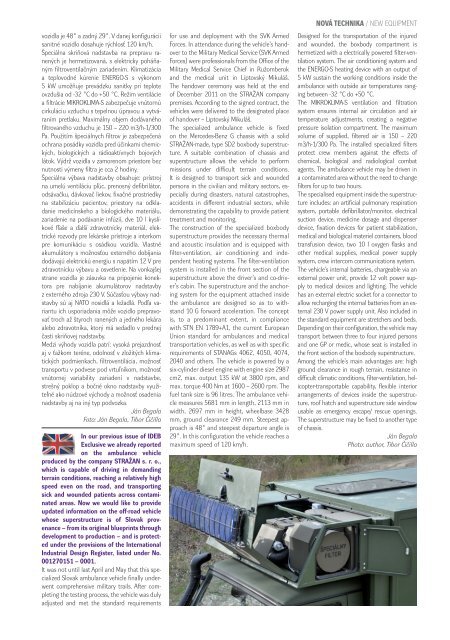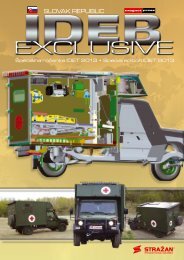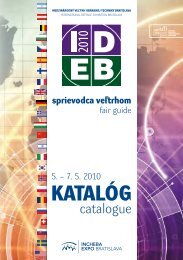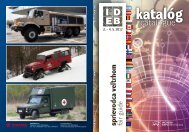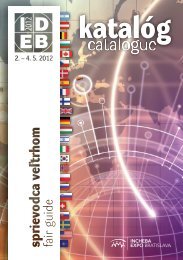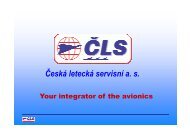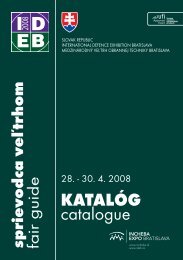tnostà - IDEB â MEDZINÃRODNà VEĽTRH OBRANNEJ TECHNIKY ...
tnostà - IDEB â MEDZINÃRODNà VEĽTRH OBRANNEJ TECHNIKY ...
tnostà - IDEB â MEDZINÃRODNà VEĽTRH OBRANNEJ TECHNIKY ...
Create successful ePaper yourself
Turn your PDF publications into a flip-book with our unique Google optimized e-Paper software.
vozidla je 48° a zadný 29°. V danej konfigurácii<br />
sanitné vozidlo dosahuje rýchlosť 120 km/h.<br />
Špeciálna skriňová nadstavba na prepravu ranených<br />
je hermetizovaná, s elektricky poháňaným<br />
filtroventilačným zariadením. Klimatizácia<br />
a teplovodné kúrenie ENERGO-S s výkonom<br />
5 kW umožňuje prevádzku sanitky pri teplote<br />
ovzdušia od -32 °C do +50 °C. Režim ventilácie<br />
a filtrácie MIKROKLIMA-S zabezpečuje vnútornú<br />
cirkuláciu vzduchu s tepelnou úpravou a vytváraním<br />
pretlaku. Maximálny objem dodávaného<br />
filtrovaného vzduchu je 150 – 220 m3/h-1/300<br />
Pa. Použitím špeciálnych filtrov je zabezpečená<br />
ochrana posádky vozidla pred účinkami chemických,<br />
biologických a rádioaktívnych bojových<br />
látok. Výdrž vozidla v zamorenom priestore bez<br />
nutnosti výmeny filtra je cca 2 hodiny.<br />
Špeciálna výbava nadstavby obsahuje: prístroj<br />
na umelú ventiláciu pľúc, prenosný defibrilátor,<br />
odsávačku, dávkovač liekov, fixačné prostriedky<br />
na stabilizáciu pacientov, priestory na odkladanie<br />
medicínskeho a biologického materiálu,<br />
zariadenie na podávanie infúzií, dve 10 l kyslíkové<br />
fľaše a ďalší zdravotnícky materiál, elektrické<br />
rozvody pre lekárske prístroje a interkom<br />
pre komunikáciu s osádkou vozidla. Vlastné<br />
akumulátory s možnosťou externého dobíjania<br />
dodávajú elektrickú energiu s napätím 12 V pre<br />
zdravotnícku výbavu a osvetlenie. Na vonkajšej<br />
strane vozidla je zásuvka na pripojenie konektora<br />
pre nabíjanie akumulátorov nadstavby<br />
z externého zdroja 230 V. Súčasťou výbavy nadstavby<br />
sú aj NATO nosidlá a ležadlá. Podľa variantu<br />
ich usporiadania môže vozidlo prepravovať<br />
troch až štyroch ranených a jedného lekára<br />
alebo zdravotníka, ktorý má sedadlo v prednej<br />
časti skriňovej nadstavby.<br />
Medzi výhody vozidla patrí: vysoká prejazdnosť<br />
aj v ťažkom teréne, odolnosť v zložitých klimatických<br />
podmienkach, filtroventilácia, možnosť<br />
transportu v podvese pod vrtuľníkom, možnosť<br />
vnútornej variability zariadení v nadstavbe,<br />
strešný poklop a bočné okno nadstavby využiteľné<br />
ako núdzové východy a možnosť osadenia<br />
nadstavby aj na iný typ podvozka.<br />
Ján Begala<br />
Foto: Ján Begala, Tibor Čičilla<br />
In our previous issue of <strong>IDEB</strong><br />
Exclusive we already reported<br />
on the ambulance vehicle<br />
produced by the company STRAŽAN s. r. o.,<br />
which is capable of driving in demanding<br />
terrain conditions, reaching a relatively high<br />
speed even on the road, and transporting<br />
sick and wounded patients across contaminated<br />
areas. Now we would like to provide<br />
updated information on the off-road vehicle<br />
whose superstructure is of Slovak provenance<br />
– from its original blueprints through<br />
development to production – and is protected<br />
under the provisions of the International<br />
Industrial Design Register, listed under No.<br />
001270151 – 0001.<br />
It was not until last April and May that this specialized<br />
Slovak ambulance vehicle finally underwent<br />
comprehensive military trails. After completing<br />
the testing process, the vehicle was duly<br />
adjusted and met the standard requirements<br />
for use and deployment with the SVK Armed<br />
Forces. In attendance during the vehicle’s handover<br />
to the Military Medical Service (SVK Armed<br />
Forces) were professionals from the Office of the<br />
Military Medical Service Chief in Ružomberok<br />
and the medical unit in Liptovský Mikuláš.<br />
The handover ceremony was held at the end<br />
of December 2011 on the STRAŽAN company<br />
premises. According to the signed contract, the<br />
vehicles were delivered to the designated place<br />
of handover – Liptovský Mikuláš.<br />
The specialized ambulance vehicle is fixed<br />
on the Mercedes-Benz G chassis with a solid<br />
STRAŽAN-made, type SD2 boxbody superstructure.<br />
A suitable combination of chassis and<br />
superstructure allows the vehicle to perform<br />
missions under difficult terrain conditions.<br />
It is designed to transport sick and wounded<br />
persons in the civilian and military sectors, especially<br />
during disasters, natural catastrophes,<br />
accidents in different industrial sectors, while<br />
demonstrating the capability to provide patient<br />
treatment and monitoring.<br />
The construction of the specialized boxbody<br />
superstructure provides the necessary thermal<br />
and acoustic insulation and is equipped with<br />
filter-ventilation, air conditioning and independent<br />
heating systems. The filter-ventilation<br />
system is installed in the front section of the<br />
superstructure above the driver’s and co-driver’s<br />
cabin. The superstructure and the anchoring<br />
system for the equipment attached inside<br />
the ambulance are designed so as to withstand<br />
10 G forward acceleration. The concept<br />
is, to a predominant extent, in compliance<br />
with STN EN 1789+A1, the current European<br />
Union standard for ambulances and medical<br />
transportation vehicles, as well as with specific<br />
requirements of STANAGs 4062, 4050, 4074,<br />
2040 and others. The vehicle is powered by a<br />
six-cylinder diesel engine with engine size 2987<br />
cm2, max. output 135 kW at 3800 rpm, and<br />
max. torque 400 Nm at 1600 – 2600 rpm. The<br />
fuel tank size is 96 litres. The ambulance vehicle<br />
measures 5681 mm in length, 2113 mm in<br />
width, 2697 mm in height, wheelbase 3428<br />
mm, ground clearance 249 mm. Steepest approach<br />
is 48° and steepest departure angle is<br />
29°. In this configuration the vehicle reaches a<br />
maximum speed of 120 km/h.<br />
NOVÁ TECHNIKA / NEW EQUIPMENT<br />
Designed for the transportation of the injured<br />
and wounded, the boxbody compartment is<br />
hermetized with a electrically powered filter-ventilation<br />
system. The air conditioning system and<br />
the ENERGO-S heating device with an output of<br />
5 kW sustain the working conditions inside the<br />
ambulance with outside air temperatures ranging<br />
between -32 °C do +50 °C.<br />
The MIKROKLIMA-S ventilation and filtration<br />
system ensures internal air circulation and air<br />
temperature adjustments, creating a negative<br />
pressure isolation compartment. The maximum<br />
volume of supplied, filtered air is 150 – 220<br />
m3/h-1/300 Pa. The installed specialized filters<br />
protect crew members against the effects of<br />
chemical, biological and radiological combat<br />
agents. The ambulance vehicle may be driven in<br />
a contaminated area without the need to change<br />
filters for up to two hours.<br />
The specialised equipment inside the superstructure<br />
includes: an artificial pulmonary respiration<br />
system, portable defibrillator/monitor, electrical<br />
suction device, medicine dosage and dispenser<br />
device, fixation devices for patient stabilization,<br />
medical and biological materiel containers, blood<br />
transfusion device, two 10 l oxygen flasks and<br />
other medical supplies, medical power supply<br />
system, crew intercom communications system.<br />
The vehicle’s internal batteries, chargeable via an<br />
external power unit, provide 12 volt power supply<br />
to medical devices and lighting. The vehicle<br />
has an external electric socket for a connector to<br />
allow recharging the internal batteries from an external<br />
230 V power supply unit. Also included in<br />
the standard equipment are stretchers and beds.<br />
Depending on their configuration, the vehicle may<br />
transport between three to four injured persons<br />
and one GP or medic, whose seat is installed in<br />
the front section of the boxbody superstructure.<br />
Among the vehicle’s main advantages are: high<br />
ground clearance in rough terrain, resistance in<br />
difficult climatic conditions, filter-ventilation, helicopter-transportable<br />
capability, flexible interior<br />
arrangements of devices inside the superstructure,<br />
roof hatch and superstructure side window<br />
usable as emergency escape/ rescue openings.<br />
The superstructure may be fixed to another type<br />
of chassis.<br />
Ján Begala<br />
Photo: author, Tibor Čičilla


